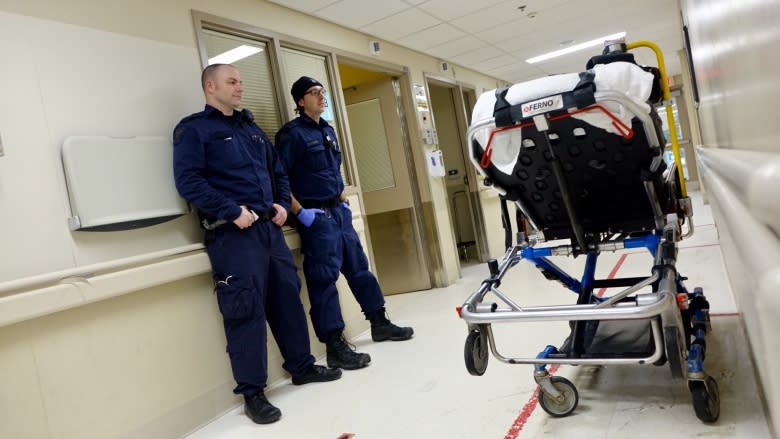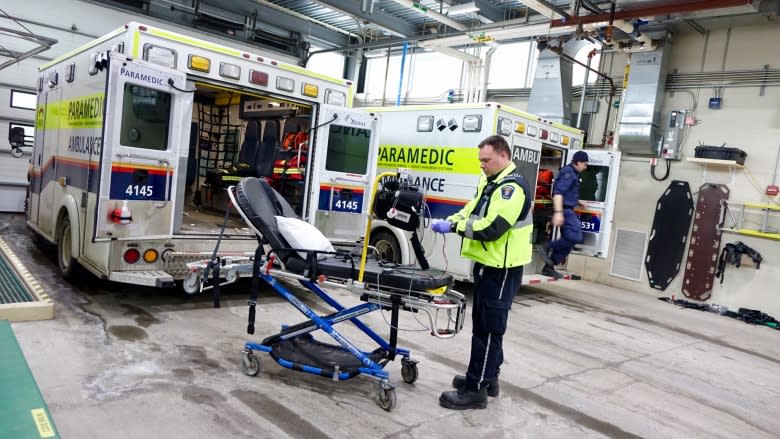ER displays aim to ease delays for paramedics
Ottawa paramedics are turning to technology to keep hospital emergency rooms up to speed on where they are, and to reduce the amount of time they have to wait around to answer their next 911 call.
The paramedic service is installing large monitors at the city's four adult hospitals. Using data from the city's emergency dispatch system, the screens will display real-time information showing when ambulances are on their way to an ER, and when it's taking too long for paramedics to be redeployed after dropping off a patient.
It's hoped the system will cut down on what's known as "offload delays" — the time paramedics spend sitting around overcrowded hospitals before they can hand their patients over for care.
On a bad day paramedics can wait up to five hours — time they're not able to spend responding to new emergencies.
"The improvement in offload means patients are going to receive care from the emergency department faster," said Greg Furlong, deputy chief of the paramedic service. "It means the next person to call 911 will hopefully get an ambulance quicker because there's more available."
Level zero alerts
The initiative follows numerous instances when the city slipped into what paramedics call "level zero." That's when there isn't a single available ambulance to respond to an emergency.
Level zero alerts used to be rare, but in 2016 they occurred more than 250 times, according to data obtained by CBC News though an access to information request.
Darryl Wilton, president of the Professional Paramedic Association of Ottawa, said more than a year later, level zero alerts continue to ring out.
"That's something that we hear daily," Wilton said. "As recently as last week you would hear level alarms going off all night long for long stretches."
The city has hired more paramedics to help deal with the issue, but Ottawa is also dealing with a growing number of 911 calls, Wilton said.
"We definitely need to try something new and innovative to get resources back in the city."
Pressure on hospitals
The first monitors were installed last week at the Montfort Hospital and the Ottawa Hospital's Civic campus. A third screen is coming to the General campus in the next seven days, and the Queensway-Carleton's will follow soon after.
The screens are programmed to turn red when paramedics have been waiting more than 30 minutes to offload a patient.
Dr. Shaun Visser, medical director of the Montfort's emergency unit, said the bright red alerts could act as "peer pressure" to encourage hospital staff to get paramedics back on the road, because the monitors show how all the hospitals are dealing with demand.
"You actually see your offload time in real time in all the emergency departments in the city," said Visser, who's also the emergency department lead for the Champlain Local Health Integration Network. "So it allows everybody to be on the same playing field and be aware of where the pressures in the system are."
System more efficient
Before the new technology came along, ER staff had to call around to find out which hospitals had capacity to receive patients, and direct paramedics accordingly. The new system promises to be more efficient, Visser said.
"We're hoping the new system will actually allow that to be done automatically to a certain degree."
The city's dispatch centre could use the tool to more evenly distribute ambulances to hospitals throughout the day, based on capacity.
Another advantage is that the system shows hospital staff exactly when an ambulance will arrive, so staff have time to prepare for the patient, especially in critical cases.
Furlong said a version of the technology could one day be made public so everyone can see where paramedics are, but that's a long way off.






